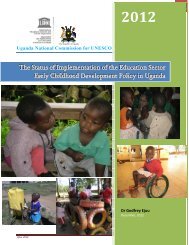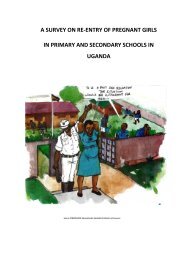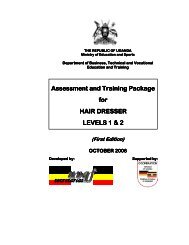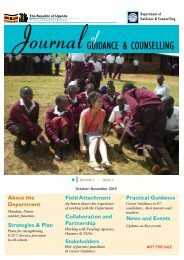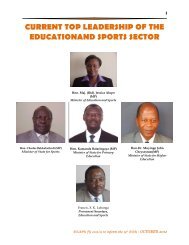Download Pdf - Ministry of Education and Sports
Download Pdf - Ministry of Education and Sports
Download Pdf - Ministry of Education and Sports
You also want an ePaper? Increase the reach of your titles
YUMPU automatically turns print PDFs into web optimized ePapers that Google loves.
111<br />
60.00%<br />
50.00%<br />
%age <strong>of</strong> students<br />
40.00%<br />
30.00%<br />
20.00%<br />
10.00%<br />
0.00%<br />
2000 2001 2002 2003 2004 2005 2006 2007 2008 2009 2010 2011 2012 2015*<br />
Female 44.08% 44.09% 45.19% 45.19% 45% 44.98% 45.5% 45.8% 45.9% 45.7% 46.6% 47% 46% 50%<br />
Male 55.92% 55.91% 54.81% 54.81% 55% 55.02% 54.5% 54.2% 54.1% 54.3% 53.4% 53% 54% 50%<br />
Year<br />
Source: EMIS 20002012<br />
It can be seen from Figure 7.15 that the gender gap has constantly been oscillating around 45% for<br />
girls <strong>and</strong> 55% for the boys between 2006 <strong>and</strong> 2009. In the last two years, Ug<strong>and</strong>a has experienced<br />
gradual increase in the percentage share <strong>of</strong> girls. Improvement in girl’s participation in secondary<br />
education is attributed to a number <strong>of</strong> factors among which include the introduction <strong>of</strong> Universal<br />
secondary <strong>Education</strong> in 2007.<br />
7.3.6 Goal 6: Quality <strong>Education</strong><br />
Goal 6 targets improving all aspects <strong>of</strong> the quality <strong>of</strong> education <strong>and</strong> ensuring excellence <strong>of</strong> all so that<br />
recognized <strong>and</strong> measureable learning outcomes are achieved by all, especially in literacy, numeracy<br />
<strong>and</strong> essential life skills. Government is firmly committed to improve the quality <strong>of</strong> education <strong>and</strong> to<br />
bring about improvement in pupils’ learning achievements <strong>and</strong> outcomes. For this matter,<br />
Government through Ug<strong>and</strong>a National Examinations Board set up realistic mechanisms for<br />
measuring pupils’ achievement. The Ug<strong>and</strong>a National Examinations Board (UNEB) conducted the<br />
National Assessment <strong>of</strong> Progress in <strong>Education</strong> (NAPE) in 1996, 1999, 2003 <strong>and</strong> 2005 for Primary 3 <strong>and</strong><br />
Primary 6 in a sample <strong>of</strong> selected schools. An analysis showing the progress in the performance <strong>of</strong> the<br />
children in primary three <strong>and</strong> six are shown in the following sections. It is important to note that<br />
Ug<strong>and</strong>a decided to use primary three <strong>and</strong> six <strong>and</strong> not primary Four as set by UNESCO.<br />
4.5.6.1 Primary Three (P.3) Pupils Rated Pr<strong>of</strong>icient in Literacy<br />
The condition or quality <strong>of</strong> being literate, especially the ability to read <strong>and</strong> write is a key indicator<br />
when evaluating the quality <strong>of</strong> learner performance (UNESO, 2005). Based on the Primary curriculum,<br />
it is assumed that pupils attending primary three are in position to read <strong>and</strong> write simple sentences.<br />
Figure 4.43 below shows trends <strong>of</strong> the percentage <strong>of</strong> primary three pupils rated pr<strong>of</strong>icient in literacy;<br />
ESSAPR FY 2011/12 to inform the 19 th ESSR – OCTOBER 2012



